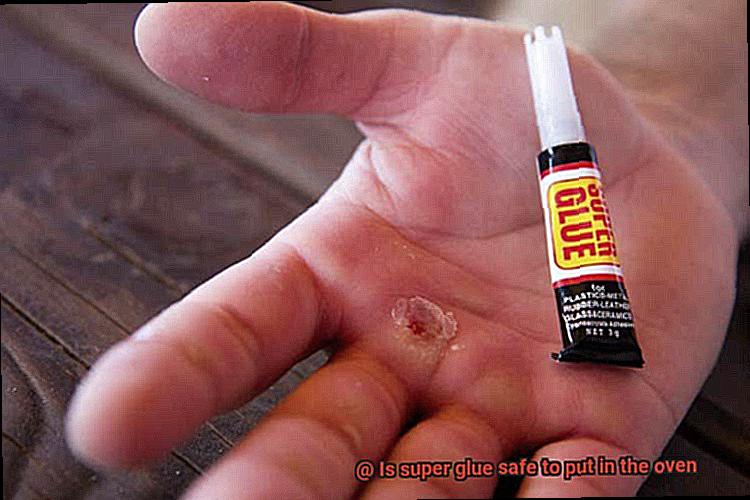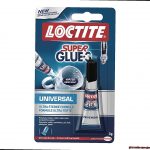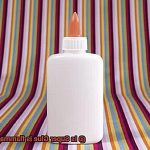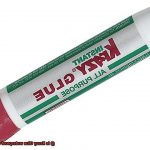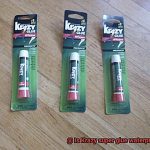The kitchen, a place where culinary magic happens, is also a hub for creative experimentation. But before you dive headfirst into unconventional methods, it’s important to consider the potential risks involved. One question that often pops up is whether super glue is safe to use in the oven.
Super glue, famous for its bonding powers, might seem like a quick fix for oven repairs or securing objects. However, jumping into this sticky situation without proper knowledge can lead to disaster. In this blog post, we’ll explore the risks and benefits of using super glue in the oven and share essential precautions to keep in mind.
Before we begin, let’s be clear: most manufacturers don’t recommend using super glue in the oven. But if you find yourself considering it as a last resort, understanding the implications is vital.
While super glue can handle high temperatures to some extent, prolonged exposure to oven heat can cause it to degrade and release harmful fumes. These fumes could contaminate food and pose health risks when inhaled. Moreover, extreme heat can alter certain glues’ chemical composition, weakening their adhesive properties and potentially leading to bond failure.
However, there may be situations where cautiously using super glue in the oven becomes unavoidable. If you’re attaching non-food-contacting objects or dealing with lower temperatures, the risks might be reduced. Still, proceed with extreme caution because it’s not the recommended course of action.
If you find yourself in such a scenario where using super glue in the oven is your only option, take these precautions seriously. First off, choose a high-temperature-resistant glue specifically designed for this purpose. Make sure it’s labeled as food-safe and suitable for ovens. Follow the manufacturer’s instructions meticulously—drying times and curing periods matter.
Ventilation is key. Keep your workspace well-ventilated during and after applying the glue to dissipate any fumes that may be released. And remember, evaluate the risks based on your oven’s design and the objects you’re gluing. Always prioritize the overall safety of your appliance and the food cooked inside it.
So, while super glue might seem like a tempting solution for oven-related repairs, it’s crucial to weigh the risks and exercise caution. With proper knowledge and precautions, you can navigate this sticky situation without compromising safety in your kitchen.
What Is Super Glue?
Contents
Super glue, also known as cyanoacrylate adhesive, is a versatile adhesive that has become a staple in households and industries worldwide. This clear and viscous liquid has the remarkable ability to bond various materials together quickly and effectively. In this essay, we will explore what super glue is, how it works, and its diverse applications.
What is Super Glue?
- Super glue was discovered in the 1940s by Dr. Harry Coover while searching for a clear plastic for gun sights during World War II.
- Composed of cyanoacrylate monomers that polymerize when exposed to moisture.
- Created by accident when Dr. Coover noticed the material sticking to everything it touched.
How Does Super Glue Work?
- Rapid polymerization process occurs when super glue comes into contact with moisture.
- Bonds surfaces together by joining the molecules together, creating a solid and durable connection.
- Speed of reaction allows for bonding within seconds.
Applications of Super Glue:
- Suitable for bonding materials like plastic, metal, wood, and ceramics.
- Ideal for fixing broken objects or creating crafts.
- Medical applications include wound closure and dental procedures.
Can You Put Super Glue in the Oven?
Get ready to don your aprons and delve into this sticky situation as we explore the fascinating world of adhesives and heat.
Understanding Super Glue:
Super glue, also known as cyanoacrylate adhesive, is a miraculous tool that can bond materials together in the blink of an eye. With its lightning-fast bonding capabilities, it has become the go-to adhesive for various household repairs and creative projects.
The Heat Dilemma:
Unfortunately, super glue is not built to withstand high temperatures like those found in ovens. When exposed to heat, this adhesive can unleash a noxious cloud of toxic fumes that could be harmful if inhaled. Trust me, we don’t want any glue-induced sniffles around here.
What Happens in the Oven:
Placing super glue in the oven can lead to disastrous consequences. The glue can melt or even vaporize, wreaking havoc on your beloved oven and releasing those pesky fumes into the air. Picture this: a sticky and smelly kitchen disaster waiting to happen. Not exactly what we had in mind for our next culinary masterpiece.
Adhesive Integrity:
Not only is putting super glue in the oven dangerous, but it also compromises the adhesive’s integrity and performance. Heat weakens the bond, making it less effective for its intended purpose. So, save your super glue for cooler projects that won’t leave you feeling stuck.
Manufacturer Recommendations:
Remember, always read and follow the instructions provided by the manufacturer when using any adhesive product. Most super glue manufacturers explicitly state that their products should avoid high temperatures or applications involving heat. They’re not being sticky about it; they just want to keep you safe.
Accidental Mishaps:
If, by chance, you find yourself with super glue on an item that needs to be heated or placed in the oven, don’t panic. Gently scrape off the dried glue or use a solvent recommended by the manufacturer to remove it before exposing the item to heat. Crisis averted.
Heat-Resistant Alternatives:
For projects that require bonding materials exposed to high temperatures, fear not. There are adhesives specifically designed for such applications. Look for heat-resistant epoxy or silicone adhesives to ensure a strong bond without compromising safety. Now you can stick it to the heat.
Potential Risks of Using Super Glue in the Oven
When it comes to cooking, we all love to experiment and try new things. But let me tell you, there’s one experiment you should never attempt in the oven – using super glue. That little tube of adhesive that can fix just about anything may seem like a quick fix for a broken handle or a loose knob, but trust me, it can have some serious consequences.
First and foremost, there’s the issue of toxic fumes. Super glue contains a type of adhesive called cyanoacrylate, which can release harmful vapors when exposed to heat. Imagine inhaling those toxic fumes while you’re cooking up a storm in the kitchen. It’s not a pretty picture, is it?
But that’s not all – super glue can also melt or become unstable at high temperatures. Instead of sticking things together, it might break down or lose its adhesive properties altogether. And if that’s not bad enough, it could even release harmful substances into your food. That’s right, you could be unknowingly adding a side dish of toxic chemicals to your meal. Yikes.
And let’s not forget about fire hazards. If super glue ignites or catches fire in the oven, it can create a dangerous situation and potentially damage your oven or even your entire kitchen. I don’t know about you, but I’d rather avoid setting my kitchen ablaze just to fix a broken knob.
But it’s not just about safety – it’s also about following guidelines and using materials that are designed for specific purposes. The FDA has not approved super glue for use in food preparation or cooking, so using it in the oven could be considered a violation of safety standards.
Heat-Resistant Super Glues
Prepare to be amazed as we delve into the captivating world of heat-resistant super glues. These extraordinary adhesives are the unsung heroes of industries like automotive, aerospace, electronics, and manufacturing. They possess the remarkable ability to bond materials under scorching temperatures. So, buckle up and let’s embark on a thrilling exploration of the benefits and considerations of using heat-resistant super glues.
Benefits of Heat-Resistant Super Glues:
- Unyielding Temperature Resistance: Ordinary super glues crumble under heat, but these specialized adhesives fearlessly withstand temperatures ranging from 300°F (150°C) to a blistering 500°F (260°C). Some variants even surpass these limits. Their resilience is truly awe-inspiring.
- Versatility in Applications: Heat-resistant super glues shine brightest in applications that involve engines, electrical connectors, and delicate circuitry prone to temperature spikes during operation. From bonding engine parts to repairing heat-sensitive devices, these glues offer a trustworthy and long-lasting solution.
- Durability Under Fire: Crafted with unique formulas, heat-resistant super glues retain their adhesive properties and structural integrity even when exposed to extreme heat. This unwavering reliability ensures that your bonds remain unbreakable when the temperature rises.
Considerations when Choosing Heat-Resistant Super Glues:
- Temperature Range: Different glues come with different limits, so it’s crucial to select one that aligns with your application’s temperature requirements. Always consult the manufacturer’s specifications to ensure your glue can handle the heat.
- Material Compatibility: While these glues are designed to tackle high temperatures, not all are suitable for every material. Take into account the composition of the surfaces you’re bonding to ensure compatibility and achieve optimal results.
- Curing Time: Heat-resistant super glues may require longer curing times compared to regular super glues. Patience is the key. Follow the manufacturer’s instructions diligently to achieve the utmost bond strength.
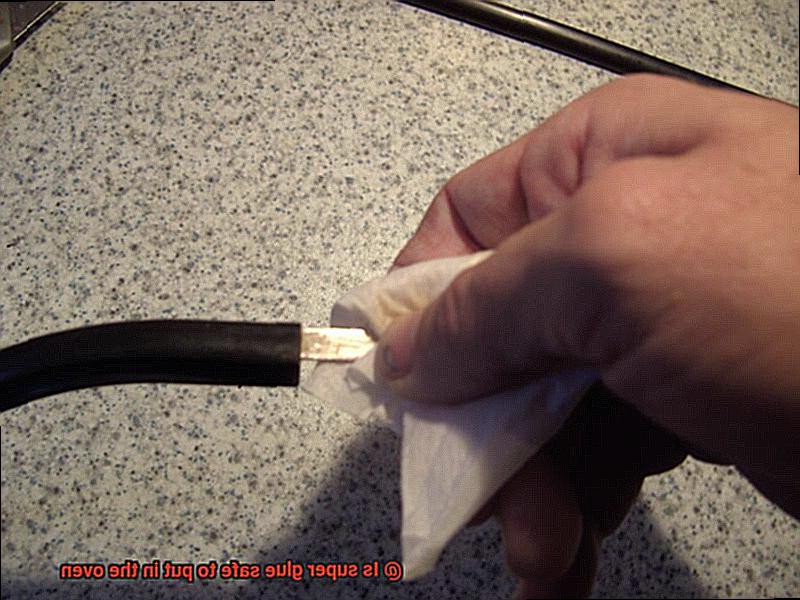
Safety First:
Remember, even heat-resistant super glues have their limits. Always adhere to the specified temperature ranges provided by the manufacturer. Pushing the boundaries could compromise the adhesive properties and render your bond ineffective.
Conclusion:
Heat-resistant super glues emerge as the heroes in industries where extreme temperatures pose a constant challenge. With their unwavering resilience, these adhesives provide a reliable bonding solution for materials that need to withstand scorching heat. Just remember to choose the right glue for your specific application, follow the instructions carefully, and never exceed the recommended temperature limits.
Safety Precautions When Using Super Glue in the Oven
Today, we’re delving into a topic that requires caution and attention: using super glue in the oven. While super glue is an exceptional bonding agent, it is ill-suited for the intense heat of ovens. However, fear not. We have compiled a comprehensive list of safety precautions that will ensure you navigate this task without getting into any sticky situations.
Dangers of Using Super Glue in the Oven:
Let’s begin by discussing the potential hazards of using regular super glue in the oven. When exposed to high temperatures, this adhesive can release toxic fumes that pose risks to your respiratory system, eyes, and skin. These fumes can be harmful if inhaled or come into contact with sensitive areas. To avoid these dangers, follow these crucial safety measures:
Ventilation:
Always work in a well-ventilated area or use a fan to keep the air circulating. Opening windows or doors allows the toxic fumes to dissipate and escape into the great outdoors. Adequate ventilation is key to maintaining a safe working environment.
Protective Gear:
Before embarking on any project involving super glue in the oven, suit up. Wear gloves and safety goggles to protect your skin and eyes from the adhesive and any potential fumes. Prioritizing safety through proper protective gear is non-negotiable.
Avoid Direct Contact:
Keep your skin and sensitive areas like your eyes out of harm’s way by employing tools such as tweezers or applicators when handling super glue. This precaution prevents accidental contact and minimizes the risk of getting glue on your skin or in your eyes.
Read and Follow Instructions:
Different brands may have specific guidelines and precautions associated with their super glue products. It is imperative to carefully read and follow the instructions provided by the manufacturer. Ignoring these guidelines can lead to unforeseen risks and compromised safety.
Proper Storage:
When not in use, store super glue in a cool and dry place. Extreme temperatures can alter the effectiveness of the adhesive or even render it dangerous to use. By storing it appropriately, you ensure the glue remains safe and ready for future projects.
Alternative Adhesive Options for High-Temperature Applications
When it comes to high-temperature applications, you need an adhesive that can withstand the heat and keep things together. Luckily, there are several alternative options available that are specifically formulated for extreme temperatures.
One popular choice is silicone adhesive. Known for its exceptional thermal resistance, silicone adhesives can handle temperatures ranging from a chilly -65°C to a scorching 260°C (-85°F to 500°F). They’re tough cookies and are commonly found in automotive, aerospace, and industrial applications. So whether you’re repairing a car engine or building a spacecraft, silicone adhesive has got you covered.
Another excellent option is epoxy adhesive. These versatile adhesives offer outstanding heat resistance and can handle temperatures up to 150°C (300°F) or even higher, depending on the specific formulation. You’ll find epoxy adhesives hard at work in electronics, automotive, and construction industries. They’re like the superheroes of high-temperature bonding.
If you need an adhesive that can handle temperatures up to 90°C (194°F) or higher, look no further than polyurethane adhesives. These bad boys are strong, dependable, and have great heat resistance. Aerospace, automotive, and marine industries love ’em. They’re like the reliable best friend who always has your back, even in the hottest of situations.
But what if you need something that can handle extreme temperatures above 260°C (500°F)? That’s where specialized high-temperature adhesives come into play. These superstars are designed to withstand the heat of furnaces, seal gaskets, and bond industrial equipment. They’re like the firefighters of the adhesive world, rushing in to save the day when things get hot.
When choosing the right alternative adhesive for high-temperature applications, it’s important to consider factors such as temperature range, materials being bonded, and the application method. Consulting adhesive manufacturers or industry experts can provide valuable guidance to ensure the best adhesive is selected for the specific high-temperature application.
pj52bbMn-XQ” >
Also Read: How To Make Super Glue Dry Faster
Conclusion
In conclusion, putting super glue in the oven is a recipe for disaster. While this adhesive may have a reputation for its unyielding bonding capabilities, it simply cannot handle the scorching temperatures that ovens dish out. Trust me, you don’t want to risk it.
One of the biggest concerns is the release of toxic fumes when super glue meets heat. These fumes aren’t just unpleasant—they can be downright harmful if inhaled and could even contaminate your precious food. And let’s face it, nobody wants a side of toxic fumes with their dinner.
But that’s not all. Exposing super glue to prolonged heat can cause it to break down and lose its grip, leaving you with a sticky situation and potentially ruining whatever you’re trying to fix. Talk about a recipe gone wrong.
Now, I get it—sometimes desperate times call for desperate measures. If you absolutely must resort to using super glue in the oven, take heed of these precautions. Look for a high-temperature-resistant glue that’s explicitly labeled as safe for use around food. Read those instructions like your life depends on it (because, well, your dinner might). And don’t forget proper ventilation to whisk away any noxious fumes that might rear their ugly head.
But here’s my advice: why not explore other options? There are adhesives out there specifically formulated for high-temperature applications—think heat-resistant epoxy or silicone adhesives. These bad boys were made to withstand the oven’s inferno and won’t leave you questioning your sanity or safety.
When it comes down to it, safety should always take center stage in the kitchen (and everywhere else). So do yourself a favor and resist the temptation to use super glue in the oven—it’s just not worth the risk. Instead, opt for safer alternatives and follow those manufacturer recommendations religiously.
Remember: when faced with the choice between convenience and safety, always choose the latter.

